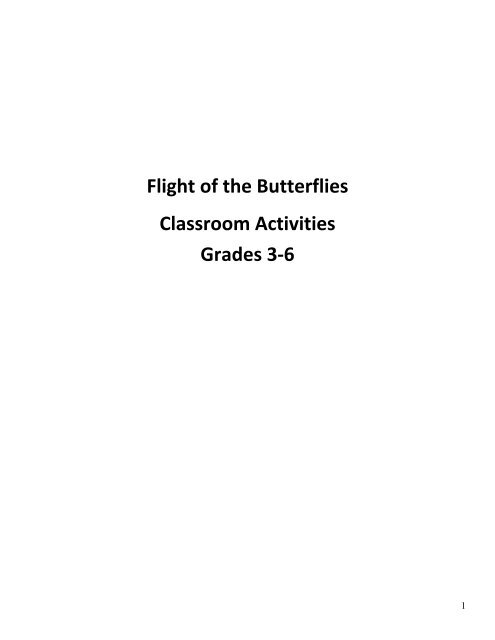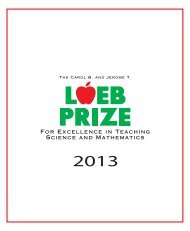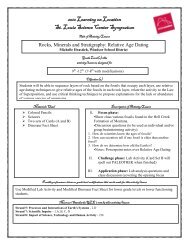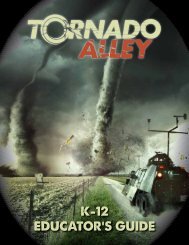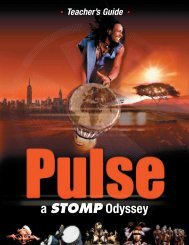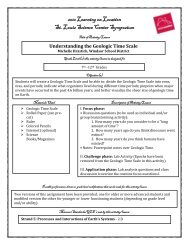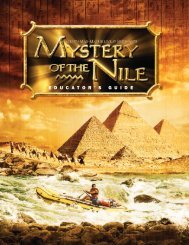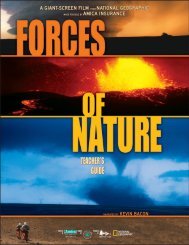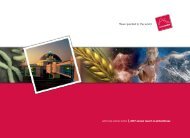Flight of the Butterflies Classroom Activities Grades 3-6
Flight of the Butterflies Classroom Activities Grades 3-6
Flight of the Butterflies Classroom Activities Grades 3-6
Create successful ePaper yourself
Turn your PDF publications into a flip-book with our unique Google optimized e-Paper software.
and <strong>the</strong>n <strong>the</strong> branch for blue eyes; you’d finish up at <strong>the</strong> end <strong>of</strong> <strong>the</strong> “freckles” branch. This is where you’dwrite that person’s name. Have small groups <strong>of</strong> students key you out.4. Assign partners and direct <strong>the</strong> students to key out each o<strong>the</strong>r on <strong>the</strong> diagram. They can add <strong>the</strong>ir namesto <strong>the</strong> correct branch on <strong>the</strong> key you have on <strong>the</strong> overhead, bulletin board or chalkboard.5. You will find that several people have been placed at a single position on <strong>the</strong> key. Ask <strong>the</strong>se students tocome to <strong>the</strong> front <strong>of</strong> <strong>the</strong> class and ask <strong>the</strong> class to discuss o<strong>the</strong>r characteristics that could identify <strong>the</strong>m(height, hair length, shades <strong>of</strong> skin and so on). Discuss how each branch on <strong>the</strong> tree causes yourclassification to become more specific. Emphasize that while this key is like those used for o<strong>the</strong>rorganisms, humans are all <strong>the</strong> same species to start with. You don’t end this exercise identifying a specific“species” <strong>of</strong> person. With organism keys, we end up with specific species.3
PEOPLE KEY4
How Far Can A Butterfly Glide?ObjectiveStudents will create paper airplanes using a templateprovided and <strong>the</strong>n modify this template to make <strong>the</strong> mostefficient glider that <strong>the</strong>y can. They will consider how factorssuch as wing position and shape affect monarchs’ ability t<strong>of</strong>ly long distances.Background<strong>Flight</strong> in nature is fascinating to watch. Some <strong>of</strong> <strong>the</strong> mostmesmerizing fliers are butterflies. With <strong>the</strong>ir erratic twists, turnsand dips, <strong>the</strong>ir flight pattern may appear downright whimsical.However, it is far from random. Consider how precisely one canlocate and land on a flower or evade a persistent butterfly net.There are many very intricately connected muscles that allowbutterflies to do this. The physics behind flight in insects,especially butterflies, is just beginning to be understood thanks to<strong>the</strong> use <strong>of</strong> high speed cameras and o<strong>the</strong>r research techniques.Members <strong>of</strong> <strong>the</strong> “Insect <strong>Flight</strong> Group” at <strong>the</strong> University <strong>of</strong> Oxfordtrained red admiral butterflies to fly toward a fake flower in asmoke filled wind tunnel and used a high speed camera to viewhow <strong>the</strong> butterflies’ wings move and push on <strong>the</strong> air around<strong>the</strong>m. O<strong>the</strong>r researchers are building working models <strong>of</strong> insects,especially dragonflies that can fly on <strong>the</strong>ir own. As important asactive flying is, it isn’t <strong>the</strong> only tool monarch butterflies use to getaround.Monarch butterflies can travel approximately 80‐90 kilometers(50‐55 miles) per day during <strong>the</strong>ir migration. This trip is onlypossible because monarchs are expert gliders; <strong>the</strong>y can sustainperiods <strong>of</strong> fight without actually flapping <strong>the</strong>ir wings or usingenergy. They are one <strong>of</strong> <strong>the</strong> few insects that can glide soeffectively. This allows <strong>the</strong>m to take advantage <strong>of</strong> <strong>the</strong>rmals(updrafts <strong>of</strong> warm air) and favorable winds, limit damage to <strong>the</strong>irwings and conserves energy. Observing gliding flight in birds andinsects led humans to invent ways to glide <strong>the</strong>mselves, usingaircraft similar to airplanes but without engines. In fact, some<strong>Grades</strong>: 3‐6Key Concepts:• Monarchs use both powered flight (flappingwings) and gliding as <strong>the</strong>y migrate.• Powered flight is more energy intensive thangliding, so monarchs take advantage <strong>of</strong>favorable wind conditions that allow glidingwhenever possible.• A paper glider can be used to illustratefeatures that make gliding both possible andmore efficient.Skills:• Following directions and modifying designbased on trials• Data collection and analysisMaterials:• Butterfly glider pattern (template anddirections provided)• Stiff paper for each student (old file folderswork well, or construction paper)• Metric tape measure or meter stick• Butterfly Glider Data Table (student handoutpage)• Scissors• Glue• Tape• Graph paper (or computer if desired)• Ruler• 2 pennies per glider• For student‐designed gliders, provideadditional paper <strong>of</strong> varying weight andstiffness; small paperclips, wax, play doughor o<strong>the</strong>r substances for weight5
glider pilots have reported seeing migrating monarchs gliding among kettles (circling flocks) <strong>of</strong> hawks a<strong>the</strong>ights near 1,500 meters (about 5,000 feet) above <strong>the</strong> ground!In this lesson students will experiment with paper glider designs that mimic <strong>the</strong> monarchs’ shape and <strong>the</strong>angle <strong>of</strong> <strong>the</strong>ir wings when gliding. If possible, students should go outside during <strong>the</strong> monarch migration toview <strong>the</strong>ir gliding patterns. Have <strong>the</strong> students concentrate on <strong>the</strong> angles <strong>of</strong> <strong>the</strong> wings so <strong>the</strong>y can work atreproducing <strong>the</strong>se angles. If it is not feasible for students to observe migrating monarchs outside, <strong>the</strong>y couldobserve monarchs <strong>the</strong>y raise and release.At first, students should use <strong>the</strong> design that we provide. They can <strong>the</strong>n try to modify and improve this designto increase flight distances. Their goal should be to make <strong>the</strong> champion butterfly glider — <strong>the</strong> one that canglide <strong>the</strong> longest distance when released from <strong>the</strong> top bleacher in <strong>the</strong> gym or when thrown outdoors on acalm day.Procedure1. Form teams <strong>of</strong> four and explain <strong>the</strong> following duties:• Thrower throws <strong>the</strong> glider• Recorder writes results on data table• Spotter marks <strong>the</strong> landing• Measurer measures flight distance2. Have students construct <strong>the</strong>ir gliders, following directions provided. Be sure <strong>the</strong>y write <strong>the</strong>ir names on <strong>the</strong>glider wings.3. Go to launch site where starting lines are laid out for each group. Allow enough room between groups toprevent in‐air crashes.4. Students should take turns launching <strong>the</strong>ir glider so <strong>the</strong>y each launch five times for a group total <strong>of</strong> 20launches. Each Thrower should complete all <strong>of</strong> her/his flights before switching duties. The number <strong>of</strong>throws per student can be adjusted to fit your time frame. Before <strong>the</strong>y start recording data, each studentshould take a few practice flights.5. After all group flights have been recorded, have each group determine <strong>the</strong> average flight distance for eachglider separately and <strong>the</strong>n for <strong>the</strong> entire group.6. Have students construct a bar graph illustrating <strong>the</strong> average flight distance in comparison with o<strong>the</strong>rs in<strong>the</strong>ir group.7. Discuss <strong>the</strong> following questions:• What variables affected <strong>the</strong> distance your glider traveled?• Would this distance be increased if gliders were launched from greater heights? (You may want to testthis experimentally.)• How could you modify your glider to improve its efficiency?8. Encourage students to compare <strong>the</strong>ir gliders to real monarchs that <strong>the</strong>y see, concentrating on <strong>the</strong> angles <strong>of</strong>both <strong>the</strong> front and rear monarch wings. Discuss <strong>the</strong> factors that affect <strong>the</strong> efficiency <strong>of</strong> <strong>the</strong> monarchs’6
Butterfly Glider Data TableName _______________________________________Directions: Record <strong>the</strong> travel distances <strong>of</strong> all <strong>the</strong> gliders in your group.Launch # Student 1 Student 2 Student 3 Student 412345Average ____________________1. Try varying <strong>the</strong> height from which you launch your glider. How does this affect <strong>the</strong> distanceyour glider flies?2. What happens to your glider if you throw it harder?8
Directions for Butterfly GliderConstruction1. Trace body/wing and fuselage templates (see patterns) onto stiff paper and cut <strong>the</strong>m out.2. Fold fuselage on all creases. Fold center crease <strong>of</strong> fuselage section so that flaps point up,<strong>the</strong>n fold outside creases A and B down.3. Place a penny on each side <strong>of</strong> fuselage front and tape <strong>the</strong>m in place. This should also seal<strong>the</strong> front <strong>of</strong> fuselage.4. Cover <strong>the</strong> entire top <strong>of</strong> both fuselage flaps with rubber cement.5. Align <strong>the</strong> fuselage with body/wing section and press toge<strong>the</strong>r.6. Allow glue to dry.7. Crease body/wing section to form a dihedral:8. Crease wing elevons to an upward position.Launching1. Hold front area <strong>of</strong> fuselage between thumb and index finger.2. Throw with a firm toss.3. Adjust creases between flights, if necessary.9
Insect Metamorphosis – A Bug’s LifeObjectiveIn Part 1, students draw (or build models) <strong>of</strong> <strong>the</strong>ir own inventedinsect, using <strong>the</strong> characteristics <strong>of</strong> insects as <strong>the</strong>ir guide.In Part 2, students study examples <strong>of</strong> various insect life cyclesand define incomplete and complete metamorphosis.They <strong>the</strong>n decide whe<strong>the</strong>r <strong>the</strong>ir insect grows through completemetamorphosis or incomplete metamorphosis and illustrate <strong>the</strong>stages <strong>of</strong> this insect’s life cycle accordingly.BackgroundAlmost all insects, and many o<strong>the</strong>r invertebrates and vertebrates (likefrogs), undergo metamorphosis as individuals develop. There are twogeneral kinds <strong>of</strong> metamorphosis for insects – complete (complex) andincomplete (simple). In ei<strong>the</strong>r case, no insect can reproduce until it isin its adult stage.Complete metamorphosis includes 4 distinct stages – egg,larva/caterpillar, pupa and adult. Insects that undergo completemetamorphosis include butterflies and moths (Lepidoptera),bees/wasps/ants (Hymenoptera), flies (Diptera), beetles (Coleoptera)and o<strong>the</strong>rs.Once <strong>the</strong> egg hatches, <strong>the</strong> larva spends all <strong>of</strong> its energy eating andavoiding being eaten. The larvae grow to a maximum size at whichpoint <strong>the</strong>y must produce a new skin and shed <strong>the</strong>ir old skin. Thestages that are produced between molts are called instars.Depending on <strong>the</strong> kind <strong>of</strong> insect <strong>the</strong>y are, larvae are known morespecifically as caterpillars (butterflies and moths), grubs (beetles) ormaggots (flies). Most <strong>of</strong> <strong>the</strong>se insects have evolved to have larvaethat are ei<strong>the</strong>r well camouflaged, bad tasting or can hide well in smallcracks and crevices.<strong>Grades</strong>: 3‐6Key Concepts:• Insects are animals that scientistshave organized as a group because<strong>the</strong>y all have common features.• Most insects go through metamorphosisas <strong>the</strong>y grow.• Some insects grow via incompletemetamorphosis (simple).• Some insects grow via completemetamorphosis (complex).Skills:• Think creatively• Apply prior knowledge• Make observationsMaterials:• Pictures <strong>of</strong> life cycle <strong>of</strong> insects withincomplete metamorphosis – at leastthree different life cycles, such asdragon fly, grasshopper, milkweedbug• Pictures <strong>of</strong> insects with completemetamorphosis –at least three differentspecies such as a sphinx moth,ladybug, honey bee• Drawing paper• Crayons, colored pencils, pensOptional:• Miscellaneous “junk” objects• Pipe cleaners• Paper tubes• Egg cartons• Paper scraps12
The Ladybug Life CycleFrom <strong>the</strong> larval stage, all insects in this group grow into a pupa <strong>of</strong> some kind (chrysalis, cocoon, pupa). It isfrom <strong>the</strong> pupa that <strong>the</strong>y will emerge as a fully formed adult.Incomplete metamorphosis includes 3 distinct stages – egg, nymph and adult (in aquatic species, <strong>the</strong> nymphstage is called a naiad). For <strong>the</strong>se organisms, <strong>the</strong>re is no pupa stage. After <strong>the</strong> egg hatches, <strong>the</strong> nymph slowlychanges, molting between stages called instars, as it grows too large for its exoskeleton. With each molt, <strong>the</strong>size and form <strong>of</strong> <strong>the</strong> nymph change slightly but throughout <strong>the</strong> process closely resembles <strong>the</strong> adult form it willeventually become. Some orders that undergo incomplete metamorphosis include true bugs (Hemiptera),grasshoppers/crickets/katydids (Orthoptera) and cockroaches (Blattodea).The Cricket Life CycleProcedurePart I1. Begin by reviewing <strong>the</strong> definition <strong>of</strong> an insect. List <strong>the</strong> following common physical traits <strong>of</strong> insects:• Head, thorax and abdomen (3 distinct body parts)• Three pairs <strong>of</strong> jointed legs13
• Hard exoskeleton• Two compound eyes as adults• Wings and antennae (common but not required)• No more than four wings2. Ask students to spend some time sketching <strong>the</strong>ir own “new” insect species. When <strong>the</strong>y come up with one<strong>the</strong>y really like, ask students to “test” <strong>the</strong>ir insect to make sure it has everything on <strong>the</strong> list you created.3. Partner students who are finished drawing with one ano<strong>the</strong>r to “test” each o<strong>the</strong>r’s insects by using <strong>the</strong> list.4. If desired, after students get <strong>the</strong>ir insect approved by a peer and by you, have <strong>the</strong>m re‐draw <strong>the</strong>ir insect ona piece <strong>of</strong> drawing paper you provide. Model for students how to use <strong>the</strong>ir whole paper or insect featureswill be too small for o<strong>the</strong>rs to see.5. Students should name <strong>the</strong>ir new species <strong>of</strong> insect.Part 21. Assign students to groups <strong>of</strong> three. Distribute life cycle samples to each group, making sure to include atleast one example <strong>of</strong> both complete and incomplete metamorphosis in each group. Do not point out <strong>the</strong>difference to <strong>the</strong> students.2. Ask students to study <strong>the</strong> life cycle pictures. Ask students what <strong>the</strong>y notice about insect life cycles. Ask“What is true <strong>of</strong> all <strong>the</strong> life cycles you are looking at?” Similarities include:• All begin with an egg• All show change over time• All end with an adult insectNow ask “What’s different among <strong>the</strong> pictures you’re looking at?” Differences include:• Some show a larva (or caterpillar or maggot) – correct students if <strong>the</strong>y use <strong>the</strong> term “worm”• Some show smaller versions <strong>of</strong> <strong>the</strong> adult getting bigger over time• Some show a pupa, but o<strong>the</strong>rs don’t (students might not know what to call this stage, so use this opportunityto teach <strong>the</strong> term pupa)3. Tell students that <strong>the</strong>y have just discovered <strong>the</strong> two types <strong>of</strong> insect life cycles. Introduce <strong>the</strong> termscomplete and incomplete metamorphosis and write <strong>the</strong>m on <strong>the</strong> board. Explain that all insects undergo14
one or <strong>the</strong> o<strong>the</strong>r. Monarchs, beetles, wasps, ants and flies are all examples <strong>of</strong> complete metamorphosis.“True bugs,” like milkweed bugs, stink bugs and boxelder bugs undergo incomplete metamorphosis, as dograsshoppers, crickets, dragonflies, mantids, walking sticks, and cockroaches.Next, ask students to bring up <strong>the</strong>ir pictures and place <strong>the</strong>m into <strong>the</strong> correct category <strong>of</strong> metamorphosis.Finally, discuss why scientists have called <strong>the</strong>se two life cycles using <strong>the</strong> terms complete and incomplete.“What is complete about a monarch’s life cycle?” “What is incomplete about a cricket’s?” This will help<strong>the</strong>m remember <strong>the</strong> terms.4. When students have seen enough examples, create a list or poster to define each <strong>of</strong> <strong>the</strong> two kinds <strong>of</strong>metamorphosis.5. Ask students to choose which kind <strong>of</strong> metamorphosis <strong>the</strong>ir invented insect uses and to illustrate each <strong>of</strong> <strong>the</strong>appropriate stages. If <strong>the</strong>y choose incomplete metamorphosis, <strong>the</strong>y should decide how many instars <strong>the</strong>irnymphs go through. If complete, how many instars do <strong>the</strong>ir larvae go through and what does <strong>the</strong>ir pupalook like?6. As students finish <strong>the</strong>ir illustrations, display <strong>the</strong>ir invented insect along with its life cycle. You might sort <strong>the</strong>inventions according to <strong>the</strong> type <strong>of</strong> metamorphosis each uses.AlternativeInstead <strong>of</strong> making final drafts <strong>of</strong> <strong>the</strong>ir insects as a drawing, students might build <strong>the</strong>ir insect out <strong>of</strong> recyclablesand o<strong>the</strong>r materials you provide. Insects could be hung in your classroom. If time allows, students might alsocreate <strong>the</strong> o<strong>the</strong>r stages <strong>of</strong> <strong>the</strong>ir insects’ life cycles and display <strong>the</strong>m as a mobile.15
The Very Hungry CaterpillarObjectiveStudents will first predict and <strong>the</strong>n estimate how much milkweed alarva consumes on a daily basis. If <strong>the</strong> research is carried over severaldays, <strong>the</strong>y will learn how much milkweed consumption varies withlarval age and size.BackgroundStart <strong>the</strong> lesson a day or so after you obtain <strong>the</strong> larvae. Part 1 should bedone on <strong>the</strong> first day, and Part 2 starts <strong>the</strong> second day <strong>of</strong> <strong>the</strong> lesson andcan be repeated daily until larvae pupate, if desired. You should use anindividual container for each larva. Larvae can be kept in clear plastic cupswith lids for several days without harm. Be sure to punch holes in <strong>the</strong> lidsto allow airflow.This lesson will not work with late fifth instar larvae (i.e. those that areabout to form a chrysalis), since <strong>the</strong>y stop eating at that time. Also, whenlarvae are molting (shedding <strong>the</strong>ir skin), <strong>the</strong>y <strong>of</strong>ten stop eating for a day.This will be interesting for students to observe. Modify this lesson if <strong>the</strong>reis not one larva per pupil.You can pick enough milkweed for several days and keep <strong>the</strong> stems in jars<strong>of</strong> water or plastic bags in <strong>the</strong> refrigerator.ProcedurePart 1—Planning and Setting Up <strong>the</strong> Experiment1. Ask students if <strong>the</strong>y have read The Very Hungry Caterpillar by EricCarle. You may wish to read it to <strong>the</strong>m at this time and ask <strong>the</strong> followingquestions:Why do you suppose Carle chose a caterpillar as his subject?Would ano<strong>the</strong>r animal subject have worked as well?What do monarch larvae eat?<strong>Grades</strong>: 3‐6Key Concepts:• Monarch larvae consume largequantities <strong>of</strong> milkweed each day.• The amount <strong>of</strong> milkweed a larvaconsumes depends on its age andwhe<strong>the</strong>r it is molting.• The amount <strong>of</strong> milkweed a larvaconsumes can be estimated inmany ways.Skills:• Observation• Prediction• Measurement• Data recording• Data reporting• Estimation• Use <strong>of</strong> percentMaterials:How can you tell how much <strong>the</strong>y have eaten since <strong>the</strong> last time you observed <strong>the</strong>m?• Monarch larvae• 10+ oz. plastic cups (one for eachlarva)• Milkweed (at least one large leafper larva per day)• Triple beam balances (or electronicscale, if you are lucky enough tohave one)• One Data Organizer: HungryCaterpillars for each student, pair,or group (student handout page)• Plastic wrap or Petri dishes16
2. Ask your students: How could you measure <strong>the</strong> amount <strong>of</strong> milkweed your caterpillar eats during a day? During 24 hours? During a week?3. On <strong>the</strong> board, list students’ ideas for measuring how much a larva eats. If it is suggested, you could use <strong>the</strong>method described here. You may also opt to use one <strong>of</strong> <strong>the</strong> o<strong>the</strong>r methods students suggest or allowgroups to pursue different methods.4. Divide <strong>the</strong> class into small groups and assign roles. Ask <strong>the</strong> Getters to come up and get <strong>the</strong> larvae for <strong>the</strong>irgroup, one piece <strong>of</strong> milkweed for each larva, and a Data Organizer: Hungry Caterpillars for each student.5. Each student should trace <strong>the</strong> milkweed leaf on <strong>the</strong> grid <strong>of</strong> <strong>the</strong> Data Organizer: Hungry Caterpillars. Count<strong>the</strong> number <strong>of</strong> squares within that leaf shape. Discuss strategies for counting partial squares. Place <strong>the</strong>milkweed and larva in <strong>the</strong> empty, clean container. Cover with a Petri dish or plastic wrap. Assure <strong>the</strong>students that <strong>the</strong>re will be enough oxygen for <strong>the</strong> larvae to brea<strong>the</strong> for one day.6. Students should estimate how much <strong>the</strong>ir larva will eat in squares or as a percent <strong>of</strong> <strong>the</strong> whole leaf, i.e.,“How many squares <strong>of</strong> leaf will your larva eat by ____ (time) tomorrow?” Have students describe <strong>the</strong>irtesting procedure (what <strong>the</strong>y will do to measure how much <strong>the</strong> larva will eat). Record <strong>the</strong> surface area <strong>of</strong><strong>the</strong> leaf tracing in squares. Students may draw illustrations <strong>of</strong> <strong>the</strong>ir procedure.7. Large larvae should get two leaves. Place <strong>the</strong> cups out <strong>of</strong> direct sunlight and away from o<strong>the</strong>r heat sources.If <strong>the</strong> room is dry, add a damp piece <strong>of</strong> paper towel or filter paper. Be sure to clean <strong>the</strong> paper every day,and replace it every few days to prevent mold.Part 2—Doing <strong>the</strong> experiment and analyzing data1. Remind students what question <strong>the</strong>y are trying to answer from <strong>the</strong> last lesson: How much food does onemonarch larva eat in a given period <strong>of</strong> time? Have <strong>the</strong>m look at <strong>the</strong>ir data sheets to see what predictions<strong>the</strong>y made. Decide how you would like to have your students compare <strong>the</strong>ir predictions to <strong>the</strong>ir results.2. Ask Getters to get <strong>the</strong> larvae for <strong>the</strong>ir table. Instruct students to get<strong>the</strong>ir log books and <strong>the</strong> Data Organizer: Hungry Caterpillars sheet.3. Set <strong>the</strong> eaten leaf directly over its tracing on <strong>the</strong> Data Organizer:Hungry Caterpillars. Students should trace around <strong>the</strong> eaten portions<strong>of</strong> <strong>the</strong> milkweed leaf. If <strong>the</strong> leaf is wilted, this must be done with careand patience. When <strong>the</strong>y are finished tracing, students need to countDay 1 Day 2<strong>the</strong> number <strong>of</strong> squares that were eaten, using <strong>the</strong> same strategies <strong>the</strong>y used in Part 1.4. Have students compare <strong>the</strong>ir estimate with <strong>the</strong>ir actual square units <strong>of</strong> milkweed eaten. Then students cancalculate <strong>the</strong> percentage <strong>of</strong> <strong>the</strong> total milkweed that <strong>the</strong> larva ate:(Number squares eaten ÷ total number <strong>of</strong> squares in <strong>the</strong> leaf) X 100 = % eaten5. As a class, find <strong>the</strong> average amount <strong>of</strong> milkweed a monarch larva eats within <strong>the</strong> time frame you chose. Youmight average <strong>the</strong> number <strong>of</strong> squares or <strong>the</strong> percentages. Before doing this, list <strong>the</strong> data on <strong>the</strong> overhead17
and ask students to estimate <strong>the</strong> average. Determine if this varies with larva size or o<strong>the</strong>r factors, such aswhe<strong>the</strong>r <strong>the</strong>y were molting.6. Assess student understanding by giving <strong>the</strong>m a leaf tracing on graph paper with an area outlined torepresent <strong>the</strong> amount that a certain larva ate during a 24‐hour period. Ask <strong>the</strong>m to estimate <strong>the</strong> amounteaten, <strong>the</strong>n count <strong>the</strong> actual amount eaten in square units. You might ask <strong>the</strong>m to calculate <strong>the</strong> percentageeaten, if an understanding <strong>of</strong> percentage is a desired outcome.7. If desired, have students graph <strong>the</strong> results overseveral days as a class or in small groups. Youcan use averages or make a separate graph foreach larva.8. Students <strong>of</strong>ten ask whe<strong>the</strong>r larvae eat at night.You may repeat this activity, measuring what waseaten during <strong>the</strong> day and night (from <strong>the</strong> timeschool ends to <strong>the</strong> next morning). Compare<strong>the</strong>se amounts.9. Modification: To make this lesson easier for youngstudents, enlarge <strong>the</strong> graph paper on <strong>the</strong> studenthandout.WHAT DOES THIS LOOK LIKE?18
Data Organizer: Hungry CaterpillarsPart 11. Estimate <strong>the</strong> size <strong>of</strong> your leaf – _____ squares2. Trace <strong>the</strong> leaf. The surface area = _____ squares3. Predict <strong>the</strong> amount <strong>of</strong> leaf your larva will eat – _____ squares4. Predict <strong>the</strong> percentage <strong>of</strong> leaf your larva will eat – _____ %19
Part 2 (<strong>the</strong> next day)5. Trace <strong>the</strong> leaf area eaten by your larva6. Count <strong>the</strong> number <strong>of</strong> units eaten – _____ squares7. Calculate <strong>the</strong> percent <strong>of</strong> leaf eaten (squares eaten ÷ total squares in leaf) X 100 – _____%20
Warning ColorationObjectiveStudents will learn about warning coloration and create an artisticrendition <strong>of</strong> an organism with warning colors.BackgroundWarning (or Aposematic) Coloration – Many poisonous or distastefulorganisms are brightly colored, usually with some combination <strong>of</strong> red,orange, yellow and white. Predators learn to associate <strong>the</strong>se colors withanimals that <strong>the</strong>y should avoid eating.Procedure1. Ask students if <strong>the</strong>y think that bright colors could ever protect butterfliesor moths from predators. They may not come up with <strong>the</strong> idea <strong>of</strong> warningcoloration. Show <strong>the</strong>m a “Mr. Yuck” symbol or a skull and crossbones labelon a container <strong>of</strong> a poisonous substance and ask <strong>the</strong>m if <strong>the</strong>y know what itmeans. They have probably learned to associate <strong>the</strong> label with many kinds<strong>of</strong> poisonous things.2. Tell your students that many butterflies are poisonous and advertise thiswith bright colors and bold patterns. Predators learn to leave brightlycoloredbutterflies, and o<strong>the</strong>r animals, alone.<strong>Grades</strong>: 3‐6Key Concepts:• Bright colors can serve as awarning to potentialpredators that an organismis toxic.Skills:• Interpretation <strong>of</strong> information• ArtMaterials:• Pictures <strong>of</strong> brightly colored,toxic frogs (see books onrainforests) and skunks• Optional: pictures <strong>of</strong> warningsigns (like stop sign, slowvehicle sign, etc.)• Optional: bottle with poisonlabel• Art supplies for student3. Compare bright patterns on toxic butterflies and moths with <strong>the</strong> colors and patterns found in symbolspeople use, like red and white stop signs and bright orange triangles on slow vehicles. These are brightlycolored so that people can easily learn to recognize <strong>the</strong>m.4. O<strong>the</strong>r toxic animals, such as frogs, have bright patterns. The bold pattern on skunks is ano<strong>the</strong>r example <strong>of</strong>warning coloration; this pattern makes it easier for an animal to learn to avoid skunks after being sprayed byone. Show students pictures <strong>of</strong> <strong>the</strong>se animals.5. Have students create and draw a fantasy animal with warning coloration. They should name <strong>the</strong>ir animaland tell what defense it has against predators.21
ObjectiveYou Don’t Taste <strong>the</strong> Way You Look:Understanding MimicryStudents will be able to explain types <strong>of</strong> mimicry, its survivaladvantage and relate Mullerian mimicry to populations <strong>of</strong> butterfliesthat may include monarchs and viceroys.BackgroundMimicry is one <strong>of</strong> several anti‐predatory devices found in nature, in whichone species called <strong>the</strong> mimic resembles <strong>the</strong> color, form and/or behavior <strong>of</strong>ano<strong>the</strong>r species. In so doing, <strong>the</strong> mimic acquires some survival advantage.There are 2 basic forms <strong>of</strong> mimicry:1. Batesian – <strong>the</strong> mimic (palatable) resembles <strong>the</strong> o<strong>the</strong>r species(unpalatable) and only <strong>the</strong> mimic benefits2. Mullerian – both species are unpalatable and both benefitMimicry provides potential survival value, especially to species whosepopulations are threatened. Mimicry, as opposed to camouflage andwarning coloration, is specifically <strong>the</strong> resemblance between two organisms.The same techniques <strong>of</strong> deception are sometimes utilized in all three antipredatorydevices. These include variations in color, pattern and structure. The viceroy closely resembles <strong>the</strong>monarch and until recently people thought that it was a harmless mimic <strong>of</strong> <strong>the</strong> toxic monarch. Howeverrecent studies have shown that it is actually slightly toxic to some predators, so it is a good example <strong>of</strong> aMullerian mimic.Procedure1. The teacher will need to prepare <strong>the</strong> unpleasant materials ahead <strong>of</strong> time to allow for drying.Grade: 3‐6, 7‐12Key Concepts:Mimicry is a form <strong>of</strong> camouflage thatin <strong>the</strong> case <strong>of</strong> Mullerian mimicrybenefits (protects) both speciesPredator/prey relationshipsSkills:Making observationsDrawing conclusions from dataMath (tables and graphing)Materials:150‐200 each <strong>of</strong> one or more <strong>of</strong> <strong>the</strong>following: Fruit Loops, Whole GrainCheerios, Gummy Savers.Concentrated lemon juice/extractChoose two colors that most closely match to represent <strong>the</strong> mimic and model species and alter <strong>the</strong>irtaste by placing in an unpleasant substance such as lemon juice extract.This will represent <strong>the</strong> species and <strong>the</strong> closely matching color <strong>the</strong> mimic.2. On <strong>the</strong> day <strong>of</strong> <strong>the</strong> activity, spread <strong>the</strong>m on a clean tray or table top in a random fashion. Have studentsrecord <strong>the</strong> number <strong>of</strong> each different colored ‘prey’ at <strong>the</strong> beginning <strong>of</strong> <strong>the</strong> activity.22
3. Explain that this activity is designed to simulate mimicry in nature and that <strong>the</strong> students will be predators.4. Have students come to <strong>the</strong> prey table and select any item <strong>of</strong> <strong>the</strong>ir choice (but do not eat it yet) and returnwith it to <strong>the</strong>ir seat.5. After all <strong>the</strong> students have returned to <strong>the</strong>ir seats, <strong>the</strong>y can eat <strong>the</strong> piece selected. The students should not revealany aspect <strong>of</strong> what <strong>the</strong>y experienced/tasted.6. Repeat steps 4 and 5 several more rounds.7. Record colors and numbers <strong>of</strong> different “prey” remaining.8. Have students create tables or graphs to represent <strong>the</strong>ir results.9. Have students answer/discuss some <strong>of</strong> <strong>the</strong> following questions; What colors remain and in what proportion? How might this exercise relate to organisms in nature? What method <strong>of</strong> evading predators does this activity illustrate? Give examples from nature that this activity simulated.23


